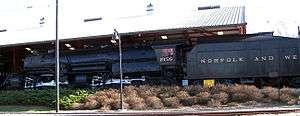Norfolk and Western 2156
Norfolk & Western 2156 is a four-cylinder compound articulated (Mallet) steam locomotive with a 2-8-8-2 (Whyte notation) wheel arrangement. The Norfolk & Western Railway built it in 1942 at its Roanoke Shops in Roanoke, Virginia as a member of the Norfolk & Western's Y6a class. It is the strongest-pulling extant steam locomotive in the world, although it is not operational. It was retired from regular rail service in July 1959, and is now owned by the Museum of Transportation in St. Louis, Missouri.
| Norfolk & Western 2156 | |||||||||||||||||||||||||||||||||||||||||||
|---|---|---|---|---|---|---|---|---|---|---|---|---|---|---|---|---|---|---|---|---|---|---|---|---|---|---|---|---|---|---|---|---|---|---|---|---|---|---|---|---|---|---|---|
 N&W 2156 on display at the Museum of Transportation in November 2008 | |||||||||||||||||||||||||||||||||||||||||||
| |||||||||||||||||||||||||||||||||||||||||||
| |||||||||||||||||||||||||||||||||||||||||||
| |||||||||||||||||||||||||||||||||||||||||||
| |||||||||||||||||||||||||||||||||||||||||||
In 2014, the museum leased it for five years to the Virginia Museum of Transportation in Roanoke, Virginia. It was towed from St. Louis to Roanoke on May 10, 2015 and towed back to St. Louis on June 10, 2020.
Historic significance
Norfolk & Western 2156 is the sole survivor of the railroad's Y5, Y6, Y6a, and Y6b classes (in final form referred to as the "Improved Y5/Y6 class"). These locomotives developed 152,206 lbs of tractive effort when built, with later modifications bringing them closer to 170,000 lbs. By comparison, the Union Pacific Big Boy locomotives developed 135,375 pounds-force (602.2 kN) of tractive effort. The only successful steam locomotives that developed somewhat more tractive effort, the Virginian AE class 2-10-10-2s, pulled trains at about 8 mph (13 km/h), while the N&W Y6's regularly pulled trains 50 mph (80 km/h), and some anecdotal evidence exists that they pulled trains up to 63 mph (101 km/h).
N&W 2156 is also one of the Y6a's that received a new firebox with an extended combustion chamber of the type used on the Y6b class, which increased drawbar horsepower from 4400 hp (3.3 MW) at 20 mph (32 km/h) to 5600 hp (4.2 MW) at 25 mph (40 km/h).
Steam versus diesel tests, upgrades, and controversies
Coal traffic was N&W's largest source of revenue, and it had arguably the most modern and efficient steam locomotives of any major U.S. railroad. Accordingly, N&W resisted conversion from coal-burning steam locomotives to oil-burning diesels longer than most. In 1952, N&W tested its A-class and Y6b-class locomotives against a four-unit Electro-Motive Division (at that time, of General Motors) F7 diesel set. The tests indicated that fuel costs and similar items were roughly the same, and the test was considered a tie. However, diesels eventually won out for lower maintenance and other operational costs.
Retrospective analyses of these tests have led to suggestions that diesel locomotive builder EMD and N&W cheated in the competition by using locomotives with secret modifications unsuited for daily work.[1][2] However, the greater weight of evidence and analysis indicates that N&W did not cheat on these tests, and that the only improvements were the ones N&W publicized and later incorporated into many locomotives.[3][4] Also, the major participants in this debate all appear to agree that N&W did ultimately modify most of its Y5, Y6, Y6a, and Y6b locomotives (including N&W 2156) with a new "intercepting/reducing valve" and ballast on the front engine, which increased their tractive effort.[5]
Operational history
Norfolk & Western used 2156 and the other Y6-class locomotives primarily for slower, heavy freight trains in the more mountainous districts in the Pocahontas, Radford, and Shenandoah Divisions. They mostly hauled manifest freight and coal trains.
When diesel locomotives took over the mainline steam operations, the Y6-type locomotives spent their last two years mostly on mine and other coal-field runs.
In July 1959, N&W donated 2156 to the St. Louis Museum of Transportation.
Current status

The museum cosmetically restored the locomotive in 1985.
In 2014, the museum agreed to lease the locomotive to Norfolk Southern and the Virginia Museum of Transportation in Roanoke, Virginia, in return for an EMD FT B unit.[6] On May 9–12, 2015, the locomotive was towed to its temporary home.
On May 31, 2015, 2156 was reunited with N&W Class A No. 1218 and the recently restored Class J No. 611 as N&W's "The Big Three".[7][8]
On June 10, 2020, 2156 left the Virginia Museum of Transportation in Roanoke, VA to go back to the St. Louis Museum of Transportation. It arrived back at the St. Louis Museum of Transportation on June 15, 2020.
References
- Le Massena, Robert A. (November 1991). "N&W's secret weapons". Trains. pp. 64–69.
- "Second section". Trains. May 1992. pp. 64–70.
- Newton, Louis M. (May 1994). "Setting the Record Straight on the Steam vs. Diesel Tests". The Arrow. Vol. 10 no. 3. pp. 14–17.
- Stephenson, David R. (January 1998). "Steam vs. Diesel: Did N&W Cheat?". The Arrow. Vol. 14 no. 1. pp. 14–18.
- "Less is More . . . (more or less)". The Arrow. Vol. 16 no. 5. September 2000. pp. 10–12.
- Norfolk Southern (May 28, 2014). "St. Louis Museum of Transportation and Virginia Museum of Transportation to trade historic locomotives" (Press release).
- Allen, Mike (May 16, 2015). "Norfolk & Western "Warhorse" back in Roanoke for steam engine reunion". The Roanoke Times.
- "Norfolk & Western's 'Big Three' to reunite May 31". Trains Magazine. May 19, 2015.
- Dixon, Thomas W., Jr.; Parker, Karen; Huddleston, Gene (2009). Norfolk & Western's Y-Class Articulated Steam Locomotives. TLC Publishing.
- Jeffries, Lewis I. (2005). N&W: Giant of Steam (revised ed.).
- "The "Largest" Steam Locomotives". SteamLocomotive.com.
External links
| Wikimedia Commons has media related to Norfolk and Western Railway 2156. |
- On display at the Museum of Transportation, July 22, 2007, Tracy Bone's Railroad Picture Archives